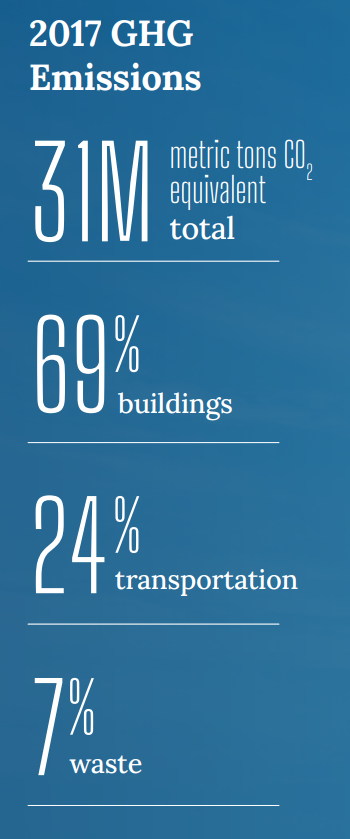Electrify Chicago
An independent tool for viewing City of Chicago building data
According to the
2022 Chicago Climate Action Plan,
69% of Chicago's emissions come from buildings, making
building emissions our biggest challenge and our biggest opportunity as a city
to tackle climate change. At Electrify Chicago, we showcase building performance using
publicly available data supplemented by community-submitted photographs and building
owners.
Start by looking at Chicago's buildings with the highest greenhouse gas intensity i.e. emissions per square foot. Large, efficient, buildings can perform much better than very inefficient small buildings on this metric.
New Article
📰 $30 Million In Missed Fines
The City Of Chicago failed to collect $30 million in potential fines from the building benchmarking ordinance, reducing transparency and accountability.
Legislative update! 🎉
As of late January 2024, legislation is being introduced to require new use more efficient forms of water and space heating, via the Clean And Affordable Buildings Ordinance (CABO), which will reduce the number of highly polluting and inefficient buildings that end up on this site.
If you're in Chicago,
write to your alderman to support the CABO!
Chicago Buildings by Greenhouse Gas Intensity
Note: Data includes large Chicago buildings with data from 2022, unless explicitly stated otherwise.
Note: This data only includes buildings whose emissions are reported
under the
Chicago Energy Benchmarking Ordinance. According to the City “As of 2016,
this list includes all commercial, institutional, and residential buildings larger than
50,000 square feet.” This dataset is also then filtered to only buildings with
reported emissions > 1,000 metric tons CO2 equivalent.
The latest year of data is from 2022, but we update the site regularly when new data is available, and some buildings may have failed to report that year, and only have older data available.
| Property Name / address | Primary Property Type |
Greenhouse Gas Intensity (kg CO2 eq./sqft) |
Total Greenhouse Emissions (metric tons CO2 eq.) |
|---|---|---|---|
|
TransUnion LLC
555 W Adams St
| Office | 3.8 kg/sqft
Lowest 8%
| 1,201 tons
Highest 39%
|
|
2609 W BELMONT AVE
2609 W BELMONT AVE
| Multifamily Housing | 3.8 kg/sqft
Lowest 8%
| 329 tons
Lowest 10%
|
|
4434 S COTTAGE GROVE AVE
4434 S COTTAGE GROVE AVE
| Multifamily Housing | 3.7 kg/sqft
Lowest 7%
| 209 tons
Lowest 2%
|
|
Robert J. Richardson Middle School
6018 S Karlov Avenue
| K-12 School | 3.7 kg/sqft
Lowest 7%
| 494 tons
Lowest 26%
|
|
1245 West Jackson Place
1241 1245 W JACKSON BLVD
| Multifamily Housing | 3.7 kg/sqft
Lowest 7%
| 423 tons
Lowest 19%
|
|
Brompton
🕰️
534-552 West Brompton
| Multifamily Housing | 3.7 kg/sqft | 402 tons |
|
-
7600 N Bosworth
| Multifamily Housing | 3.7 kg/sqft
Lowest 7%
| 477 tons
Lowest 24%
|
|
Smyth -CPS
🕰️
(CPS)
1051 W 13th Ave
| K-12 School | 3.7 kg/sqft | 445 tons |
|
Stevenson, Adlai E -CPS
(CPS)
8010 S Kostner Ave
| K-12 School | 3.7 kg/sqft
Lowest 7%
| 526 tons
Lowest 28%
|
|
Henry Elementary, Patrick -CPS
(CPS)
4250 N St Louis Ave
| K-12 School | 3.7 kg/sqft
Lowest 7%
| 329 tons
Lowest 11%
|
|
Hamline Elementary-CPS
(CPS)
4747 S Bishop St
| K-12 School | 3.7 kg/sqft
Lowest 7%
| 428 tons
Lowest 19%
|
|
Appleville Condominium
501 W 24th Pl
| Multifamily Housing | 3.7 kg/sqft
Lowest 7%
| 923 tons
Highest 48%
|
|
IL2125ZZ-QUINCY COURT BLDG
🕰️
11 W Quincy Ct
| Office | 3.7 kg/sqft | 451 tons |
|
3525 W. Peterson Avenue
🕰️
3525 W Peterson Ave
| Office | 3.7 kg/sqft | 214 tons |
|
420 W MELROSE ST
420 W MELROSE ST
| Multifamily Housing | 3.7 kg/sqft
Lowest 7%
| 212 tons
Lowest 3%
|
Data Source:
Chicago Energy Benchmarking Data
